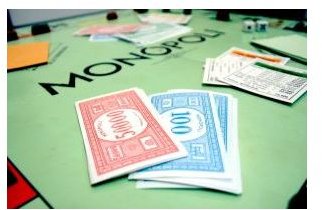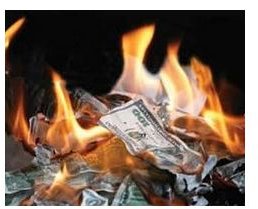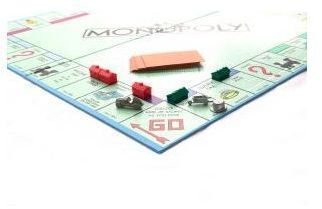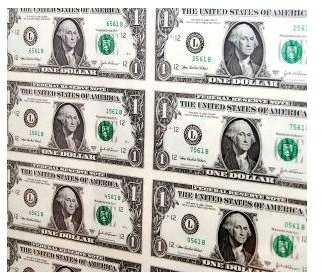Greenspan Says Print More Money: The Fed and Our Fiat System
Them Is Fightin’ Words
Former chairman of the Federal Reserve Bank Alan Greenspan made the news again recently in a statement found by many to be
outrageous: “The United States can pay any debt it has because we can always print money…So there is zero probability of default.” This was on NBC’s Meet the Press, according to Patrick Allen of CNBC on August 7. To the average person, this is anathema; nobody wants to just print more money. Let’s take a look at what Greenspan said and what throwing more money at our problems would probably mean.
Greenspan’s words took me back to long-ago days with a long-ago boyfriend who always lured me into one game or another, and I lost every time. No matter how wily I played, I ended up in bankruptcy (Monopoly) or holding a handful of high-point cards (Uno).
Actually, I quit playing Uno with him altogether on the day I caught him cheating. While he was holding up his cards, through the thin areas of his cable knit sweater sleeve, what did I see but the colors of not one but two Draw Four cards—plus a Reverse card! I was flabbergasted and I never played cards of any kind with him again.
Not-So-Funny Money

With Monopoly, no matter how strictly I adhered to Generally Accepted Accounting Principles (GAAP), I always lost. Initially I played the favorite strategies from my childhood: I saved my money so I could snatch up the railroads and utilities—I just blindly loved those public properties. But he always managed to make more monopolies than I did. I unfailingly stuck myself with Oriental, Vermont and Connecticut; he always landed before I did on prime spots like Boardwalk and Park Place. I invariably ended up with Baltic and Mediterranean; he wrangled his way onto Marvin Gardens and its sister properties as well as the Pacific trio. Adding insult to injury, he regularly snagged at least one of the railroads I was aiming to own.
In the meantime, he busily bought houses and then set up motels on his streets. With the rents he charged, it never took long until I was too broke to pay him. Slowly, I would sadly sell back to the bank the few houses I had managed to buy (you couldn’t, of course, put houses on the railroads and utilities) and then the unimproved lots. When I was really ready to bite the fishbone, just like the bankrupt guy in the video game version of Monopoly, he would throw cash my way. “Here! Have some money! Let’s keep playing!”
I never wanted to take his cash. He talked me into it, but that’s another column entirely. Once I paid my debt, even as I made it around the board again and redeemed a few properties, I dreaded rolling anything less than a 12 when I returned to that part of the game board. In fact, by that stage of the game, I welcomed going directly to jail—even without passing Go, it was cheaper than paying the horrible rent on his hateful holdings.
My money only had value because he placed value on it, very similar to the fiat system of dollar valuation that became standard practice about 40 years ago. Most people share in common some level of confusion about the value of money circulating in the country today—isn’t there some pile of gold or silver buried deep under a mountain to back up all that money?
So, Why Not Print More Money?
Well, we still have lots of gold (near as I can find, about $25 billion worth), but the fact is that our country’s monetary system based

on gold ended in 1971 when Richard Nixon was president. He put the “gold standard” to an end following a period when several countries insisted on redeeming dollars for considerable amounts of bullion, and many other countries followed suit. Today, economists worldwide—people anywhere who are trying to calculate the true value of money—disagree whether or not a return to the gold standard would put us back on an even dollar-for-nuggets keel, or whether we would just end up paying less for gold fillings in our teeth.
So, why not print more money? It looks so easy when you’re watching a cable news station, with the news promos showing us pages of hundred dollar bills rolling off the printing presses, presumably at the Federal Reserve Bank. The implication is that we need more money, we are spending more money, and we owe more money. All we have to do is print, print, print more money!
One of the big arguments between conservatives and liberals these days is whether to float more money into our available cash reserves, as Greenspan suggested. Mostly the liberals favor it while the conservatives scoff at such short-sighted stupidity. “You can’t just print more money,” they sneer superciliously, “It won’t have any worth, and you’ll diminish the value of what few programs are still left in place.”
The Role of the Federal Reserve Bank
The truth is, since 1971, the money already has only the worth that it is perceived to have—that is how the fiat system works. People who deplore the stimulation of the economy with an influx of money fail to recognize or accredit the job done by the Fed. The Fed’s main

function is to control the amount of money circulating in the United States, and it does that by both printing and destroying money. On the same day that you see all those crisp, clean Benjamins rolling off the presses, what you don’t see are the dirty, torn dollars that are shredded or burned.
The Fed also holds the job of preserving the cost of borrowing money—the interest rates that banks can charge. When it adds more money than it destroys, it keeps interest rates low. Decreasing the money supply means that interest rates rise and inflation results.
What Some People Think
Some moderate liberals like Bill Clinton (the only president in the past 40 years to operate with a cash surplus) recommend that some programs can be cut and revenues can be increased—a compromise between both liberal and conservative wish lists—but either of these should be done only slowly.
Economist Paul Krugman, author of “The Conscience of a Liberal” for the NY Times, explained on August 15th with a voice that will calm any uncertain liberal why we can’t just print more money. The key to improving the economy, he says, does not depend on the influx of new dollars if those dollars cannot be called upon for the good of our businesses. We must convince investors that the bonds offered by our Treasury Department promise real future worth, so that the dollar maintains credibility and we continue to sell bonds. As our available cash is put to use developing businesses—buying those little green houses and red motels, for example, although I hate any reference to real estate at this time—our cash reserves will grow and will become a bigger part of our holdings.
On the Move Without More Money
Do I think Alan Greenspan—former chairman of the Fed—lost his bonkers and promoted an outrageous strategy? No, I do not. I think he was making the point that our fiat system prevents this country from defaulting on its debts because printing more cash is an available strategy. I think he meant no more and no less. On the other hand, since Greenspan kept interest rates unnaturally low in the years leading up the crash of 2008, maybe he meant exactly what he said. I prefer, like Messrs. Clinton and Krugman, to move slowly and

cautiously, to preserve confidence in the dollar.
In Monopoly, I finally dropped the beloved habits of childhood and went after that boyfriend of mine with a vengeance. If I landed on a property, I bought it. When I landed on the Free Parking space–a genuine public entitlement–I took all the money that was there. Pretty soon I built great monopolies. Sometimes I only got the St. James properties or Illinois, et al, Avenues and somehow he always maneuvered to land on Boardwalk ahead of me, but I no longer needed him to float money into the game. By spending money on my monopolies, I was able to reap money.
References
-
Additional Resource:
ABC Nightline by Jake Tapper and Michael S. James. Proposes Debt Impasse Deal, but Fears GOP Too Hamstrung by Ideology, 6/30/11, retrieved at http://abcnews.go.com/Politics/bill-clinton-exclusive-proposes-debt-impasse-deal-fears/story?id=13963218
-
Images
sxc.hu, bearwicke, please visit www.garrisonphoto.org/sxc, license
